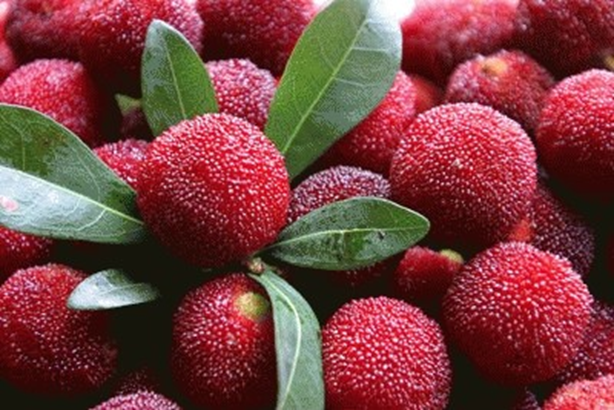Bayberry is a fruit that has been used for generations as traditional medicine. This fruit, which is quite popular in China and America, is considered to have a number of benefits, such as having strong antioxidant compounds.
Bayberry is a type of berry in the myricaceae family. The most popular bayberries are Chinese bayberry (Myrica rubra) and American bayberry, also known as wax myrtle (Myrica cerifera).
Bayberry trees grow year-round and go by many names, including candleberry, waxberry, and yang-mei. The following article discusses the most popular types of bayberry, their nutritional content, and their potential benefits.
The most popular types of bayberry
Here is an explanation of the two most popular types of bayberry.
- Chinese Bayberry (Myrica rubra)
Myrica rubra is a fruit native to South China and various other Asian countries. This type of bayberry is reddish in color and has a delicious taste with high nutritional value. Chinese bayberry is rich in antioxidants such as anthocyanins and can be consumed directly as fresh fruit or processed into various products. Bayberries, including Myrica rubra, are perishable fruits. Besides being eaten fresh, this Chinese fruit is generally available in the form of juice, canned fruit, frozen fruit, or dried.
- American Bayberry (Myrica cerifera)
Myrica cerifera is a large shrub or small tree widely distributed in the southern and eastern United States. The fruit is small and bluish white.
This type of berry is famous for its fruit that can produce wax (wax) to make fragrant bayberry candles. In addition, the leaves, branches, and roots have also been widely used.
Traditionally, bayberry has been used for generations as a remedy for various health problems.
Bayberry content
Bayberry is rich in phytochemicals, which are natural plant chemicals that have the potential to carry a number of health benefits; and antioxidants, such as vitamins A, C, and E. This fruit is considered to have very high levels of vitamin C and is considered a good source of folate.
Bayberries, especially Chinese bayberries, have a good acid-sugar balance and are a great source of thiamine, riboflavin, carotenoids, minerals and dietary fiber. In addition, this fruit is equipped with antioxidants, such as anthocyanins, flavonols, and ellagitannins.
This type of berry also contains important minerals, such as calcium, magnesium, potassium, iron, and copper. There are also phenolic compounds, including gallic acid, quercetin hexoside, quercetin deoxyhexoside, to quercetin.
Chinese bayberry even contains abundant oligomeric proanthocyanidins (OPCs), which are the most powerful class of free radical-scavenging antioxidants. OPC is said to be twenty times stronger than Vitamin C and 50 times stronger than Vitamin E, and is very beneficial for maintaining a healthy body.
Potential health benefits of bayberry
Although there are many claims of the benefits of bayberry and it has been used for generations as herbal medicine, it still takes a lot of scientific research to prove the claims of effectiveness of using bayberry for treatment.
So far, the use of bayberry fruit is more in the form of traditional medicine with testimonies by word of mouth.
- Herbal Medicine in Traditional Chinese Medicine
Traditional Chinese medicine has relied on the bayberry plant for a long time. Bayberry bark is used to treat arsenic poisoning, skin diseases, wounds, and ulcers.
Meanwhile, the seeds are used to treat sweaty feet and the flesh of this Chinese fruit is used to treat cholera, heart disease, and gastric diseases such as peptic ulcers.
- High Content of OPC Compounds
The content of OPC in bayberry fruit is a very strong antioxidant compound. OPC is believed to be able to ward off and clean free radicals from the body.
These compounds can even penetrate the blood brain barrier, potentially protecting the brain and nervous system. OPC is also believed to prevent cataracts, skin aging, and help relieve arthritis.
- Versatile Bayberry Oil Producer
Bayberry leaves can produce oil that is rich in natural compounds with antifungal and anticarcinogenic properties. A number of studies have also shown extracts and oils from bayberry leaves to have acaricide, insecticidal, pesticide, and arthropod-repellent properties.
- As a Traditional Herbal Medicine in America
Bayberry has been used as an herbal remedy for the inside and outside of the body. This type of berry is believed to improve blood circulation, stimulate breathing, and control bacterial infections.
Here are the claims of the benefits of bayberry for a number of problems in the body.
- Diarrhea
- Irritable bowel syndrome
- Fever
- Have a cold
- Influenza
- Excessive menstruation
- vaginal discharge.
For the external body, bayberry is believed to be able to overcome the following problems.
- Ulcer
- Sore throat
- Wound
- Itchy skin
- Dandruff.
Bayberry wax is also used to treat dysentery and treat ulcers. Meanwhile, bayberry leaf tea is used to treat fever and itchy skin.
The need for digital IT is needed in everyday activities, Bead IT Consultant is the right choice as your partner, visit our website by clicking this link: www.beadgrup.com

